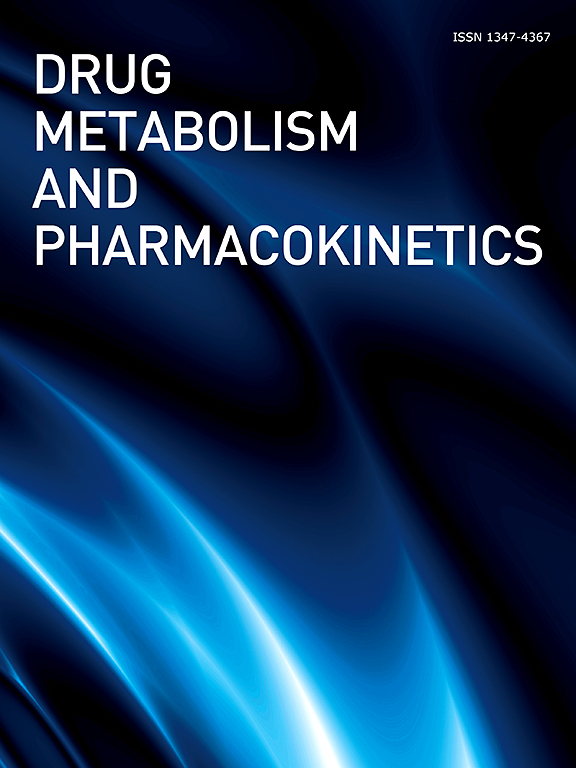Investigation of an OATP1B inhibitory effect by a cyclic peptide using the endogenous biomarker coproporphyrin-I in monkeys
IF 2.2
4区 医学
Q2 PHARMACOLOGY & PHARMACY
引用次数: 0
Abstract
Peptide drugs are expected to be a new modality that will replace traditional small molecule drugs. As the number of approved peptide drugs increases, they are being co-administered with various drugs, but there is a limited number of reports on their drug-drug interaction (DDI) in both in vitro and in vivo (clinical) studies. In this study, we investigated the transporter inhibitory potential of Compound A, a macrocyclic peptide (3.5 kDa) for the treatment of pain. We found that Compound A exhibited a strong inhibitory effect on the organic anion transporting polypeptide (OATP) 1B in an in vitro study. To assess the in vivo OATP1B inhibitory potential, Compound A was intravenously or subcutaneously administered to monkeys, and the plasma concentration of coproporphyrin-I (CP-I), an endogenous biomarker of OATP1B, was determined. Compound A markedly increased the CP-I concentration in monkeys. A semi-mechanistic pharmacokinetic model analysis using the CP-I concentration revealed that Compound A is a highly potent in vivo OATP1B inhibitor (in vivo Ki, OATP1B: 59.9 ng/mL as total plasma concentration). Our findings suggest that even peptides with a large molecular weight can cause DDI. These results offer valuable information for the further development of DDI guidelines for peptides.

利用内源性生物标志物coproporphyrin-I研究环肽对猴子OATP1B的抑制作用
肽类药物有望成为替代传统小分子药物的一种新形态。随着批准的多肽药物数量的增加,它们正在与各种药物共同给药,但在体外和体内(临床)研究中,关于它们的药物相互作用(DDI)的报道有限。在这项研究中,我们研究了化合物A的转运蛋白抑制电位,化合物A是一种大环肽(3.5 kDa),用于治疗疼痛。我们在体外研究中发现化合物A对有机阴离子转运多肽(OATP) 1B具有较强的抑制作用。为了评估体内对OATP1B的抑制潜力,我们将化合物A静脉注射或皮下注射给猴,并测定了OATP1B内源性生物标志物co - proporphyrin- i (CP-I)的血浆浓度。化合物A显著提高了cp - 1在猴子体内的浓度。利用cp - 1浓度的半机械药代动力学模型分析显示,化合物A是一种高效的体内OATP1B抑制剂(体内Ki, OATP1B: 59.9 ng/mL作为总血浆浓度)。我们的研究结果表明,即使是分子量较大的肽也能引起DDI。这些结果为进一步制定多肽DDI指南提供了有价值的信息。
本文章由计算机程序翻译,如有差异,请以英文原文为准。
求助全文
约1分钟内获得全文
求助全文
来源期刊
CiteScore
4.80
自引率
9.50%
发文量
50
审稿时长
69 days
期刊介绍:
DMPK publishes original and innovative scientific papers that address topics broadly related to xenobiotics. The term xenobiotic includes medicinal as well as environmental and agricultural chemicals and macromolecules. The journal is organized into sections as follows:
- Drug metabolism / Biotransformation
- Pharmacokinetics and pharmacodynamics
- Toxicokinetics and toxicodynamics
- Drug-drug interaction / Drug-food interaction
- Mechanism of drug absorption and disposition (including transporter)
- Drug delivery system
- Clinical pharmacy and pharmacology
- Analytical method
- Factors affecting drug metabolism and transport
- Expression of genes for drug-metabolizing enzymes and transporters
- Pharmacogenetics and pharmacogenomics
- Pharmacoepidemiology.

 求助内容:
求助内容: 应助结果提醒方式:
应助结果提醒方式:


